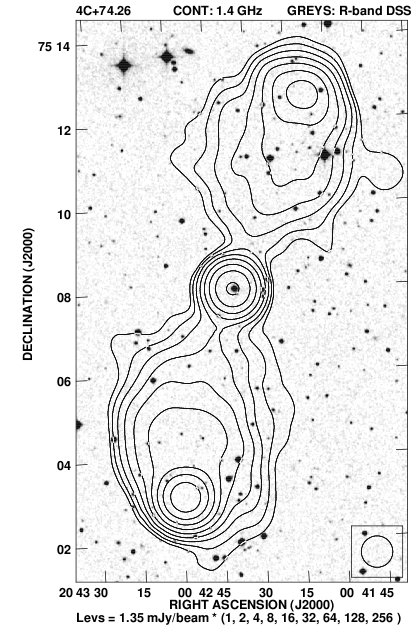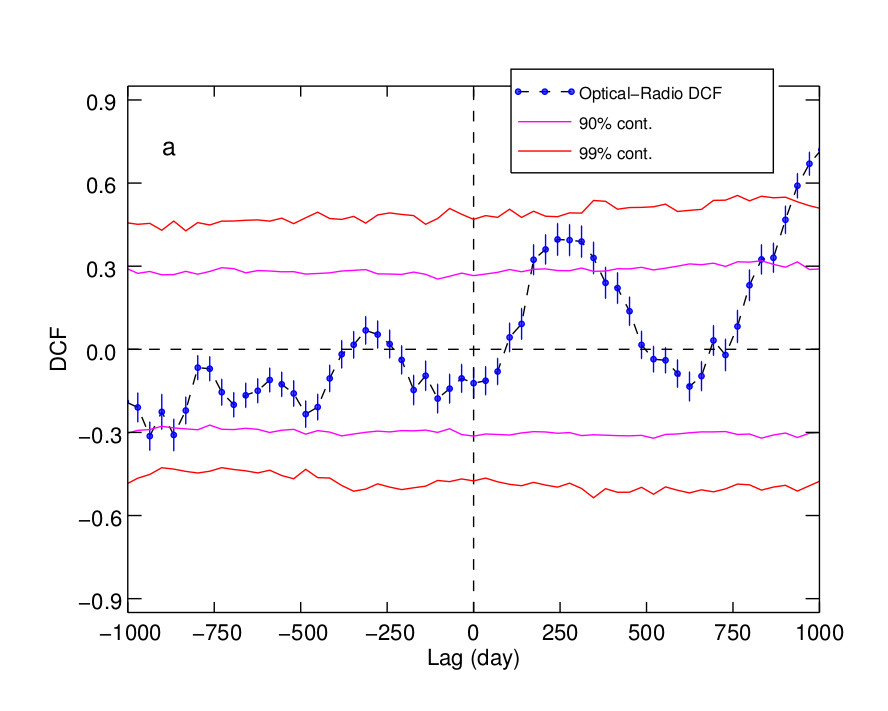Astronomy Object of the Month: 2019, January
< previous Archive next >
Possible link between relativistic jets and accretion disk found in the giant quasar 4C+74.26
4C+74.26 is a quasar located about 1.4 billion light years away from us - one of the few quasars which has giant radio
lobes spreading across millions of light years. An international team of researchers led by Dr. Gopal Bhatta from the
Jagiellonian University in Kraków studied the source using multifrequency observations from the ground and space based
telescopes. The optical observations were obtained mostly from Suhora and Krakow observatories, and 15 GHz radio
observations were gathered from the 40-m telescope at the Owens Valley Radio Observatory
(OVRO). Observations from the hard X-ray space
telescopes, Swift/BAT and
NuSTAR, were also included in the study.

Illustration 1: Hard X-ray image of the source from the NuSTAR space telescope (false colors). Credit: the Authors.

Illustration 2: Giant quasar 4C+74.26 in radio and optical band. Radio intensity contours at 1.4 GHz from NVSS (Condon et al. 1998) are overlayed on optical R-band DSS image at the center.
Credit: the Authors.

Illustration 3: Optical and radio light curves of the quasar 4C+74.26. The peak of the blue curve shows that optical emission is delayed behind radio emission by ~250 days. The magenta and red curves are the 90% and 99% local significance levels, respectively.
Credit: the Authors.
The team studied correlation between multiwavelength emission and discovered that the optical emission delayed behind radio emission by ~250 days. The authors proposed that the delay may indicate a scenario in which flux modulations arose due to magnetic disruptions at the innermost regions of the accretion disk: the modulations first propagate through the relativistic jets and later across the truncated disk. Such a lag between two emission bands is relatively rarely observed and it could help in understating the most challenging issues in modern astrophysics: how relativistic jets are launched from the vicinity of fast rotating supermassive black holes and the interaction between the disk and the jet.
Quasars are the central regions of active galaxies - so luminous that they outshines the whole galaxy. They are powered by the accretion of the matter onto supermassive black holes that are billion times more massive than the Sun. A small fraction of quasars emitting profusely in the radio band are known as radio-loud quasars. The sources launch the most powerful relativistic jets that eject matter with extremely high speeds. On the radio images these jets appear to extend up to a large distance from the central engine, and in some cases radio knots show superluminal motion with apparent velocity up to ~37 times the speed of light.
The sources are so far away that the central region can not be resolved by the current instruments. However, as they are highly variable, astronomers utilize this variability properties to understand the processes occurring near the central engine. Quasars, the most luminous sources on the sky, are also used to map distribution of the dark matter which shape the large scale structures of the Universe. Studying quasars sheds light on various aspects, e.g. the growth of black holes in the early Universe, and origin of relativistic jets.
4C+74.26 is a quasar with unimaginably giant radio lobes extending up to 3 million light years from the central black hole. The team conducted cross-correlation analysis of its long-term light curves and discovered that the optical emission was delayed behind radio emission by ~250 days. Since relativistic jets in active galactic nuclei (AGN) are widely believed to be launched by magnetic fields supported by the disks and entering the ergospheres of spinning black holes, the flux changes could be naturally identified with magnetic perturbations within the innermost parts of the accretion disk. Therefore, to further zoom into the central engine, the team performed spectral analysis for the source using hard X-ray observations from NuSTAR space telescope. The modeling accounted for some of the exotic events, including blending of the light and space-time drag near the fast rotating supermassive black holes.
The results of the study suggest the idea that both the observed disk variability at optical wavelengths and the jet variability at radio band are generated by magnetic field fluctuations within the innermost parts of the disk, and the lag we observe between the disk and the jet emission is related to a much delayed radiative "response" of the disk to magnetic field fluctuations when compared with relativistic jet timescales at sub-parsec distances from the core.
Original publication: Signatures of the Disk--Jet Coupling in the Broad-line Radio Quasar 4C+74.26 (Gopal Bhatta et al. 2018, The Astrophysical Journal).
The research was conducted at the Departments of High Energy Astrophysics and Stellar and Extragalactic Astronomy of the Jagiellonian University’s Astronomical Observatory (OAUJ). The work was supported by the Polish National Science Centre through the grants 2012/04/A/ST9/00083, UMO-2017/26/D/ST9/01178, 2016/22/E/ST9/00061, 2013/09/B/ST9/00599, 2018/29/B/ST9/02004, 2013/10/M/ST9/00729 and 2015/18/A/ST9/00746.
|
Gopal Bhatta Astronomical Observatory Jagiellonian University G.Bhatta [at] uj.edu.pl |


